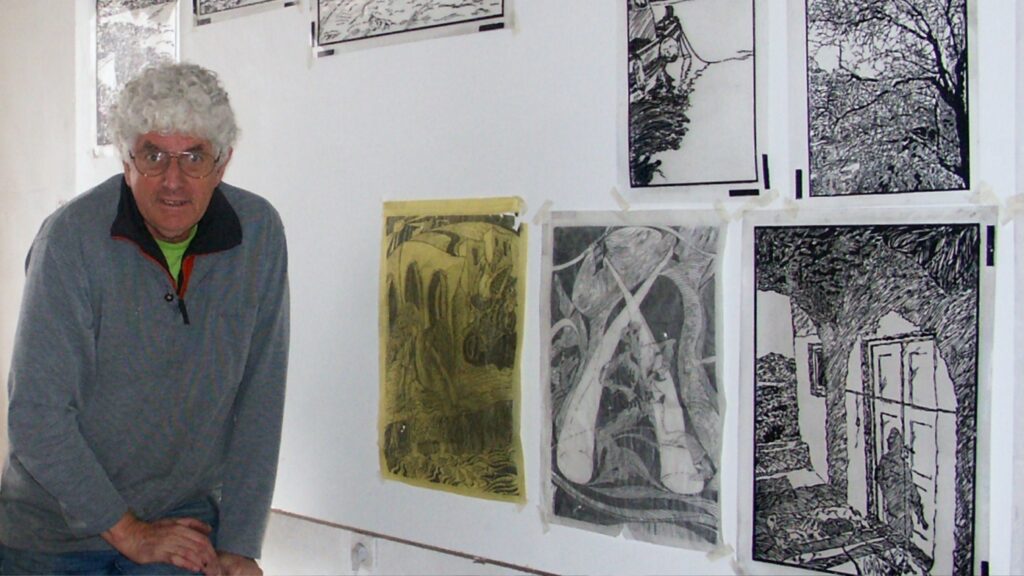Michael Winters, an Australian artist born in 1943, embarked on a lifelong artistic journey ignited by his art studies at the Caulfield Institute of Technology during the early 60s and a passion for the history of art, particularly the archaic wonders of Greece. This passion set the path for a transformative voyage.
In 1965, Michael departed Melbourne on board the “Patris” for Athens, an inspiring starting point with its many archaeological marvels and urban tapestry. However, the path ahead remained uncertain until an unexpected encounter onboard changed everything.
A chance meeting with Greek traveller, Antoni Tsaloumas, proved most fortunate. An invitation to visit Tsaloumas’ home on Leros marked the beginning of a profound connection with both the island and Greece as a whole. This initial visit laid the foundation for a lasting relationship that deeply influenced Winters’ artistic endeavours.
Upon his return to Australia in 1974, Winters met Antoni’s brother, Dimitri Tsaloumas. Dimitri, a noted writer and poet who had migrated here earlier, presented him with the opportunity to illustrate a collection of his poems. This collaboration not only initiated a close friendship but also marked the start of a series of illustrated works that would span years.
Winters’ subsequent visits to Greece, particularly Leros, were marked by a growing inspiration drawn from the rich experiences that Greece offered. This inspiration resulted in his designation as an Honorary Citizen of Leros by the Municipal Council in 1995, an acknowledgment of his deep connection to the island.
The influence of Greece on Winters’ artistic expression became increasingly evident as he delved into the creation of linocuts, capturing the essence of Greek landscapes and the human narrative within them. In 1990, during a two-year stay in Crete, he created a body of work that became a significant part of the Australian Government’s tribute to the 50th anniversary of the Second World War’s Battle of Crete. This collection interwove military history with mythology, resulting in an exhibition at the Australian War Memorial in Canberra in 2005. https://www.awm.gov.au/visit/exhibitions/lookingback
Winters’ artistic voyage has traversed international boundaries, with exhibitions in Greece, Sweden, England, and across Australia. His works have also been submitted for the Archibald Prize on three occasions.
More recently, the inclusion of his work in the Greek Australian Cultural League’s annual “Antipodean Palette” exhibition in Melbourne, held profound significance for him. In her welcoming speech, the GACL President, Cathy Alexopoulos OAM, thanked Winters for accepting the League’s invitation to launch the 2023 art event, acknowledging the continuing relationship he has cultivated with Greece as a true Philhellene.
Michael’s journey from Melbourne to the shores of Greece has been one of profound artistic evolution and cultural enrichment, where he has woven the landscape, history and people of Greece into the very fabric of his art.
A selection of Michael’s art work will soon be showcased at the upcoming GACL launch event of the annual bilingual periodical ‘Antipodes’. This year’s issue of the periodical is a special tribute to the Philhellenes of Australia and commemorates the 50th anniversary of its inaugural publication. The GACL invites all to attend this free celebratory event and cultural gathering which will take place at 570 Victoria Street, North Melbourne on Sunday, October 22nd, 2023 at 3:00 PM.
Michael’s profile and artworks can be found on the GAAD (Greek Australian Artist Directory), an archive for Greek art practice in Australia and a valuable resource for curators, collectors, researchers, and anyone interested in exploring Greek Australian art. The GAAD encompasses Greek Australian visual and performance artists as well as artists from various backgrounds who have been inspired by Greek culture. This initiative was first proposed in 2020 as a means to support artists during and after the Covid pandemic. Its main purpose is to ensure the preservation of our cultural identity and the recognition of the value and history of Greek artists in Australia.
Source : Greekherald


